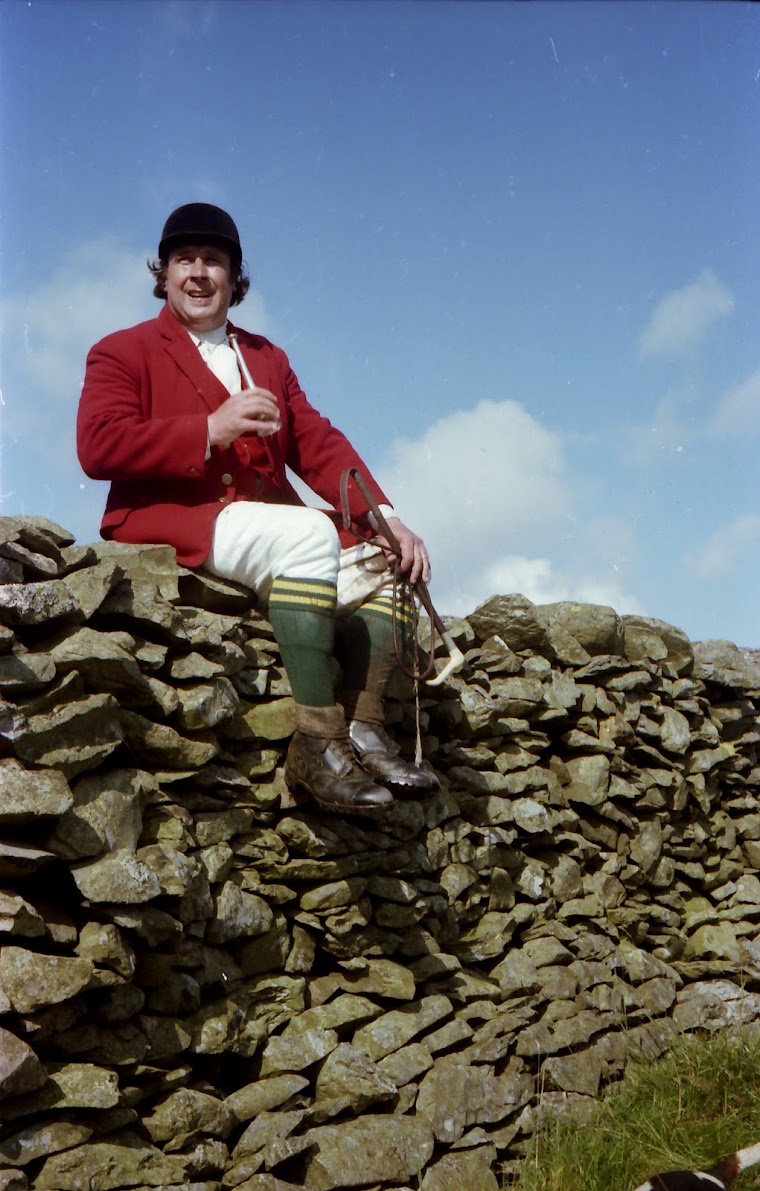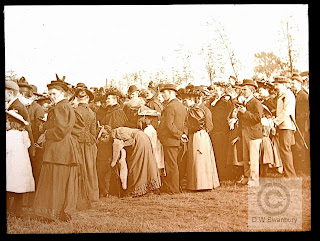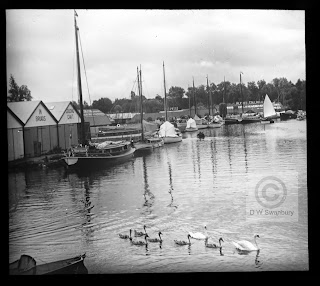Since I am told the Colne Valley Beagles and the Holme Valley beagles are fogged off today, it being a typical miserable gloomy foggy wet morning just now that makes being on the moors probably out of the question. I thought I might amuse myself doing something a bit different. (As it turned out they weren't fogged off and I was misinformed. Oh well, another opportunity missed!)
My grandfather was a very keen photographer and naturalist amongst other things. He lived in an era when exploring and understanding nature was something many were interested in. As an amateur photographer with a big plate camera this tended to mean his photographs were of rather inanimate things such as the flora and fauna and also of old church doorways and other things that frankly seem to make most of them useless now. However amongst the mouldering collection remaining there are one or two that look interesting and I have managed to find out how to get a half decent digital reproduction without spending money.
So why not share them?
The photographer - Thomas Henry Lodge born 1869
He lived in Normanton and worked for the Midland Railway
His son pictured here died, maybe at Cambrai in March 1918 with no known grave and is recorded on the Arras memorial Interestingly, the Midland Railways, where he had been a clerk after leaving school, produced a remembrance book of all those brave men of the Midland Railways who gave their lives in the Great War. 2,833 were killed out of 22,941 who served and 7,068 were wounded or invalided with 738 taken prisoner. Their workshops also contributed to the war effort with all manner of ordnance and equipment. I don't know if it is still there but they erected a war memorial at Derby in 1921 to the 2,833.
William Thomas Livesey Lodge Private 241458 5th Batt Seaforth Highlanders
24 April 1897 - 21 March 1918.
I still have his sporran, spats and a few other bits but his glengarry was consumed by moths and had to go.
Tomas Henry's family were from Skelmanthorpe. There was a farm off the main street in Skelmanthorpe in those days called Manor Farm, nicknamed Fisher Fold, as the Fisher family had it. He married the youngest daughter, Sarah Jane. W.T L. Lodge was born at Manor Farm.
This is Joah Fisher, the only son of William and Matilda Fisher, with Violet the horse. Manor Farm was pulled down in the days when Field's mill was thriving but Manor Barn still stands and is a wonderful structure and worth a look inside.
This is Joah Fisher, the only son of William and Matilda Fisher, with Violet the horse. Manor Farm was pulled down in the days when Field's mill was thriving but Manor Barn still stands and is a wonderful structure and worth a look inside.
This is my grandmother, the eldest being W.T.L. who died in the Great War, the next became the headmaster of Skelmanthorpe Junior and Infant School for most of his life until he retired. The small boy dressed like a girl as they did in those days, had an exciting life around Canada and the US when he emigrated as a young man to become the overseer at a sugar plantation in Oahu, Hawaii. He was by Pearl Harbour when the Japanese attacked, was another keen photographer and a major in the Oahu Defence Volunteers.
So much for a brief background.
Now assorted pics in no particular order.
Looks like Joah again with Violet and a staged scene of 'striking a bargain'.
Another 'bargain is struck' picture
Lowestoft
Bridlington harbour
Canon Cooper of Filey in Robin Hood's Bay 1930. Canon A N Cooper was vicar of Filey for 55 years. He was an outstandingly good chap and was called the walking vicar averaging 30 miles a day! He did a vast amount of good for the locality.
Cheddar Lion Rock.
Fish dock at Plymouth about 1930
and
Fishing Boat at Lowestoft and another boat called Peewit around 1920
Fishing boats, Ocean's Gift and another at Lowestoft
Fishpool Street, St Albans
French Row, St Albans
Barge going under a Yarmouth bridge
I suspect this may be a bought one - Lower Broad Street, Ludlow
More Yarmouth
RMS Mauretania may have been taken my my Uncle who emigrated to the US as he lugged a plate camera around for a while
Gunthwaite Hall near Upper Denby - Ancient Oak
Couple of men sitting under a wonderful old dead tree with fine buildings behind.
This is said to be the grave of a large number of Cromwell's men who died in an epidemic. In its prime it was 36ft in diameter. (Information from `The Penistone Scene' by A.N. Brownhill) (Actually 36ft diameter sounds a bit extravagant. Does he mean circumference I wonder?)
A Midland Railway station but which I wonder?
Mons Meg in 1929 - Edinburgh Castle -
"Mons Meg is one of two surviving 'bombard gun's presented to King
James II by his uncle by marriage, Phillip the Good, Duke of Burgundy
in 1457.
The name 'Mons' comes from where they were made 'Mons" which is in present day Belgium.
The 6 ton, muzzle-loading canon is capable of firing gunstones weighing 150kg nearly 2 miles."
The name 'Mons' comes from where they were made 'Mons" which is in present day Belgium.
The 6 ton, muzzle-loading canon is capable of firing gunstones weighing 150kg nearly 2 miles."
Mr Johnson - no idea who he was. Looks about right for the job!
Caphouse colliery, Overton - 1930
Now the National Mining Museum near Wakefield - http://www.ncm.org.uk
An image from one of the slides given to the museum there as they had none of the old winding gear in their collection and so these are now on display there. Well worth a visit.
North Landing, Flamborough 1929
Old Yarmouth Wherry - Breydon Water 1931
Pub at St Alban's 1929
Staithes
Robin Hood's Bay lifeboat - 1930 Still rowing!
Blacksmith's Arms, Staithes
Don't know who this is but he is well kitted out!
Scarborough harbour
Settle market place
Shandy Hall, Coxwold, Yorks, 1932
I can't read the faded white ink on this one. It looks something like Bulsher Row but beats me.
Staithes
The King visits Wakefield - 1912 I think
This looks about the same era but I cannot read the writing. Looks nicer in the original sepia of this slide as I tried the conversion but somehow no so evocative.
The old bridge bridge, Teigmouth - about 1930 The very first bridge was made of wood and was designed and built by Roger Hopkins. It was claimed at the time to be the longest wooden bridge in England with a length of 1,632 feet and 34 arches and the second longest bridge in Europe. It had stone abutments at both ends and a swing bridge at the Teignmouth end to allow passage for tall masts. It as rebuilt between 1927 -1931 and from what I can tell this is not quite as it is today
Thirsk 1931
The tug Tactful with barges in tow at Lowestoft
Lowestoft fishing boat LT910 coming home 1930
Moorred fishing boats and tugs Lowestoft 1930
Lowestoft
I wonder where this is?
Another where I can't read the faded ink
Wells market place
Wroxham Broads 1931
Windermere 1931
Ye Old Fighting Cocks round house, St Albans.
Originally, the pub was known as the 'Round House,' likely because of the round-ish, octagonal structure that makes up the main section. As the sport of cock fighting gained a foothold, the pub was re-branded as Ye Old Fighting Cocks, sometime in the 19th century. Today, this country-inn style pub is known locally as "The Fighters."
York Station
Threshing.
As the song goes -
"My mind wanders back in a moment of joy to the days of the thresher when I was a boy"
Leading
I don't know if these will be of interest. One or two are seriously good I think. I am not sure if the next generations will be interested in this stuff as they cannot connect to it in the same way that mine can. Mine spans a link between a completely new age and one now gone with its feet in the past.


 .
.























































